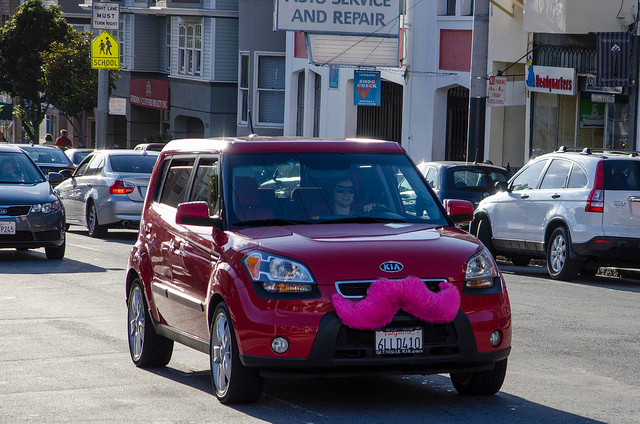It’s been a hard road to reconcile Seattle’s broken taxi system with the as-of-yet unregulated environment in which popular smartphone-based ‘ridesharing’ companies like Lyft, Uber and Sidecar have been operating.
The plan that City Councilmember Mike O’Brien unveiled at a committee meeting last week doesn’t come close to doing what I’ve previously suggested ought to be done—removing taxi caps entirely, regulating vehicles-for-hire and drivers to make sure they are safe, and letting the market sort out how many cars-for-hire ought to be on the road.
I would still advocate for that in a perfect world. This would help unlock the vast untapped potential of ridesharing in personal cars, especially if companies like Lyft or Sidecar grow beyond providing cab-lite service and employ thousands of drivers who pick people up and share space in their cars when they’re already on the road. This is a transformative, sustainable solution that expands transportation choices and costs taxpayers nothing.
But we live in a more complicated real world, one with a specific history. Thousands of taxi and for-hire vehicle drivers—many, many of whom are immigrants who support families on the fares they collect—have spent years working under a set of illogical and innovation-killing rules that we, as a city, have imposed upon them.
The two-year pilot program proposed by O’Brien could serve as a reasonable bridge between the old and new systems, if the different parties were willing to try. It’s not clear that they are, and it’s entirely possible that if the city adopts his proposal, at least some and possibly all of the ridesharing companies will pack up and take their services elsewhere.
Still, his plan represents a balanced attempt to:
- protect reasonable interests of taxi and for-hire drivers who have spent years following the rules in the current system, and who arguably deserve some support while we transition to a better one
- allow new ridesharing companies to continue to operate, though certainly not with the freedom they would like
- begin to expand the pool of legal vehicles-for-hire that are available to pick people up in Seattle and move the city towards a more open system
- begin to correct an imbalance of power by forcing dispatch companies—whether Yellow Cab or Uber or Lyft—to compete for the services of legal drivers and vehicles
- put safety protections in place for customers, drivers, and pedestrians
What the latest proposal does
O’Brien’s latest plan improves upon the regulations proposed in December by the city of Seattle’s Taxi, For-Hire, and Limousine Regulations committee, which zeroed in on the new Transportation Network Companies (TNCs). (That’s the city’s new name for smartphone-based vehicle-for-hire dispatch companies such as Uber, Lyft, and Sidecar). By limiting each of those companies to 100 vehicles on the road, the regulations would have killed ridesharing, full stop.
O’Brien’s proposal wouldn’t limit number of cars the TNCs could use, but in order to grow, the ridesharing companies would have to draw from the pool of existing taxi and for-hire vehicles instead of relying solely on part-time fist bumpers.

The working proposal would increase the number of legal for-hire vehicles on the streets of Seattle from roughly 900 today to 1,350. This is a step in the right direction towards lifting historic license caps that haven’t served consumers or drivers well.
The city would open up a lottery for at least 150 new taxi vehicle licenses over the next two years, which would go to hardworking drivers who have never had the opportunity to own their own legal cab.
Then, as part of a two-year pilot program, the city would establish a lottery for 300 new “TNC driver permits,” for which the musicians, parents, substitute teachers, and other folks driving their own vehicles for companies like Lyft and Sidecar and UberX would have to compete. (More on what this number ought to be below).
Under the plan, TNC drivers would also have to go through city training. Those who want to drive less than 16 hours a week could opt for a less intensive licensing program geared toward more casual drivers. If they want to drive more hours, they would have to go through the same two-day training that Seattle’s taxi and for-hire drivers are required to attend.
The TNC companies would also have to provide additional insurance coverage designed to cover some of the liability gaps that currently exist in their model. Lyft, incidentally, introduced a plan this week to bridge some of those insurance gaps, though the city of Seattle would like them to go further. One of the biggest differences of opinion is when that company insurance would be required to kick in—when a driver is “active” on the app driving around or only when he or she has a passenger to pick up.
There are legitimate arguments on each side of that question, but like the other areas of disagreement between the council’s for-hire committee and the TNCs, it seems like the differences could be bridged if everyone got creative.
What could go right
Beyond that, the various dispatch companies and drivers would be largely left alone to sort things out on their own. The ridesharing companies could continue to operate, dispatching a TNC permit holder with a pink mustache on a Jeep or a for-hire Prius. A taxi driver could affiliate with Yellow Cab (Puget Sound Dispatch) or Orange Cab (Seattle Taxi Dispatch) or Lyft or Uber—essentially whoever offers him or her the best deal. This gives drivers more power and leverage to negotiate with the different dispatch companies.
I understand why O’Brien’s plan doesn’t go further. Some city officials are afraid that removing all caps on the number of licensed taxis overnight and allowing an unlimited number of rideshare drivers to join them would be too much change, too fast. Until the market finds its level, real wages could decline as additional cars-for-hire hit the streets. There would likely be winners and losers, and it could be that some of the drivers who have existed for years within the confines of the current taxi and for-hire system—who are overwhelmingly immigrants and people of color—would be among the losers.
So a two-year pilot program that allows for experimentation and helps move the city towards an open entry system—one that fully realizes the benefits to people and the planet of a thriving and unfettered market for rides in Seattle—makes some sense.
What could go wrong
The danger in O’Brien’s plan is that it won’t provide enough opportunity for the substitute teachers, students, single moms, and yes—immigrants and people of color—who have begun to depend on companies like Lyft or UberX for a substantial part of their income. And that these innovative companies simply won’t see enough growth potential here to stick around. Though I have no evidence, I suspect that 300 TNC permits isn’t nearly enough for them to thrive.
But the reason that neither I—nor any city official—knows what that number should be is that Uber, Lyft, and Sidecar have refused to disclose how many drivers they employ. And without knowing that, it’s hard to guess what the reasonable number of new TNC driver permits ought to be.
The companies are standing on principle and arguing that those numbers have nothing to do with regulating health and safety, which is absolutely true. They would like Seattle to follow the model pioneered in California, where regulators chose to focus only on health and safety issues and decided the state had no business limiting the number of people who want to earn extra income from ridesharing.
Yet there are historic and cultural and political reasons that Seattle may not go that route, at least in the meantime. Let’s hope that before the Seattle City Council starts voting on new regulations, which could begin as early as Friday, the TNCs share enough information to help the city craft an interim solution that could work for them. And that the city listens to those companies and tries to arrive at a number that provides opportunity for new drivers and for those companies to continue to provide a wildly popular service. Because if they leave, Seattle will be the poorer for it.


Comments are closed.